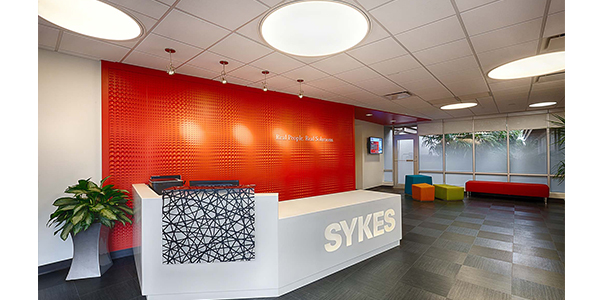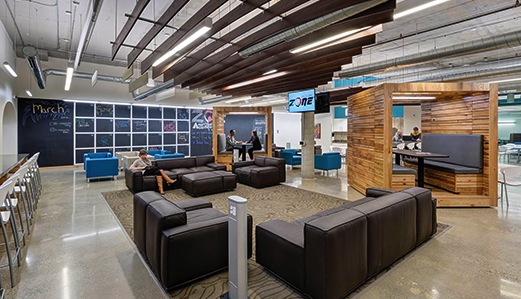Over the summer, I had the opportunity to speak about future workplaces as a panel member at ULI Florida’s 2014 Summit. I was excited to join my peers from across the state in what was a worthwhile and eye-opening discussion, and I was encouraged that the resounding takeaway was “design matters.” In this new world of work, one size doesn’t fit all; employers need strategically designed spaces that support their goals in unique ways.
For years, corporate design trends have been largely generalized as “me-to-we,” which I believe is an oversimplification. While it’s true that there’s still a transition away from workplaces dominated by private, secluded offices and toward more open, collaborative space, there’s so much more going on. Companies – and specific groups/departments within companies – are seeking varying degrees of mobility, flexibility, sustainability and customizability, making good design solutions much more complex than they once were.
We know that technology and urban density are propelling a major shift toward worker mobility. Designers need to be smart about space allocation and do our best to design workstations that can be used by a rotating string of people – Jim today, Jessica tomorrow – making sure there’s space available to be shared. This, in turn, ties into the notion of flexibility and balance.
We all fantasize about how much we could accomplish if the phone would stop ringing, emails would stop dinging, and colleagues would stop popping in. And research has proven that the ability to concentrate and reduce noise results in increased innovation, job performance and job satisfaction. So alongside the open workstations and group meeting spaces, there must also be “heads down” spaces, private alcoves, places for focus and respite. Design that lets workers seek out the balance they need to do good work is essential.
Most companies these days are also looking for sustainable design to some degree. Not every client wants or can afford a full-blown LEED Platinum space, but there are plenty out there thinking about energy costs and long-term savings. And what’s already a very long list of sustainable design capabilities continues to grow every day. Environmentally-focused solutions are a significant part of the design conversation, and that won’t be changing anytime soon.
But the importance of mobility, flexibility and sustainability in the world of corporate design are already well-established. A newer trend that’s gaining deserved attention is customizability, and how it will look in the coming years. During the panel, I made what some might consider a controversial statement, but it’s something I believe nonetheless: the CRE market simply hasn’t kept up with the workplace design revolution in terms of tenant improvement allowances (TIAs).
Customizability gives tenants of a corporate space the opportunity to “make it their own.” Unfortunately for many tenants, that process has become quite cost-prohibitive. They incur enormous costs in personalizing their office space, and it’s money that they’ll never get back if and when they vacate the building. It’s because TIAs, for the most part, don’t cover enough.
I believe that TIAs should, at the very least, allow for the kinds of improvements that enable companies and their individual employees to feel comfortable. Things like demountable walls and furniture and even wall murals allow a company to express who they are. One of GS&P’s clients, Sykes Enterprises, Inc., wanted their new call center in Lakeland, Fla., to be energetic, collaborative and healthy in order to attract and retain younger staff members.
Elements like brightly colored, geometric-shaped seating and wall-mounted TV screens helped to create the ideal environment. The call center would have been a very different place – a much more generic place – without the ability to reinforce the SYKES brand throughout.

GS&P customized the Sykes Enterprises call center in Lakeland, Fla., with plenty of unique design features that support SYKES' and its employees' personalities.
Another key aspect of customizability occurs at the individual level. Employees are happier and more successful in a space that reflects their identity and inspires creativity, rather than one that’s bland and impersonal. And the millennial generation, more than any other generation before it, places serious value on self-expression.
Just like people want their home to be a reflection of who they are, the same applies to workspaces. Employers are increasingly focused on validating employees’ unique contributions, and giving workers the opportunity to customize their space supports the notion that uniqueness is valued. A company that fosters self-expression through design is truly on the cutting edge.
It’s also worth noting that I think the money spent upfront on TIAs is a worthwhile investment for landlords too, not just tenants. A successful tenant with satisfied employees will be a happier customer over the long term, potentially leading to longer leases and positive referrals. And an attractive, sustainable workspace will certainly be a more valuable property over the long term.
Every company’s recipe for workplace success is unique, so every solution must be tailored. As we move above and beyond the “me-to-we” conversation, our work as designers becomes more complex and more important. The combinations of mobile, flexible, sustainable and customizable features are seemingly endless, and it’s our job to identify the mix that will best support success today, tomorrow and years down the road.
About the Author
Leith A. Oatman, IIDA, LEED AP, has more than 25 years of experience and is a principal of GS&P's Corporate and Urban Design studio in Jacksonville, Florida. In addition to developing business for the corporate studio, she actively manages and designs large to small multi-disciplined projects in corporate and hospitality sectors. Leith has been honored as one of the Jacksonville Business Journal's Women of Influence, is a board member of the Ronald McDonald House Charities, Inc. and is a Distinguished Alumni of the University of Florida's School of Design, Planning, and Construction.
More from Author
Gresham Smith | Oct 16, 2024
How AI can augment the design visualization process
Blog author Tim Beecken, AIA, uses the design of an airport as a case-study for AI’s potential in design visualizations.
Gresham Smith | Aug 17, 2023
How to design for adaptive reuse: Don’t reinvent the wheel
Gresham Smith demonstrates the opportunities of adaptive reuse, specifically reusing empty big-box retail and malls, many of which sit unused or underutilized across the country.
Gresham Smith | May 24, 2023
Designing spaces that promote enrollment
Alyson Mandeville, Higher Education Practice Leader, argues that colleges and universities need to shift their business model—with the help of designers.
Gresham Smith | Apr 24, 2023
Smart savings: Commissioning for the hybrid workplace
Joe Crowe, Senior Mechanical Engineer, Gresham Smith, shares smart savings tips for facility managers and building owners of hybrid workplaces.
Gresham Smith | Mar 20, 2023
3 ways prefabrication doubles as a sustainability strategy
Corie Baker, AIA, shares three modular Gresham Smith projects that found sustainability benefits from the use of prefabrication.
Gresham Smith | Jan 19, 2023
Maximizing access for everyone: A closer look at universal design in healthcare facilities
Maria Sanchez, Interior Designer at Gresham Smith, shares how universal design bolsters empathy and equity in healthcare facilities.
Gresham Smith | Dec 20, 2022
Designing for a first-in-the-world proton therapy cancer treatment system
Gresham Smith begins designing four proton therapy vaults for a Flint, Mich., medical center.
Gresham Smith | Nov 21, 2022
An inside look at the airport industry's plan to develop a digital twin guidebook
Zoë Fisher, AIA explores how design strategies are changing the way we deliver and design projects in the post-pandemic world.
Gresham Smith | Feb 13, 2022
Helping maximize project dollars: Utility coordination 101
In this post, I take a look at the utility coordination services our Transportation group offers to our clients in an attempt to minimize delays and avoid unforeseen costs.
Gresham Smith | May 7, 2021
Private practice: Designing healthcare spaces that promote patient privacy
If a facility violates HIPAA rules, the penalty can be costly to both their reputation and wallet, with fines up to $250,000 depending on the severity.
















